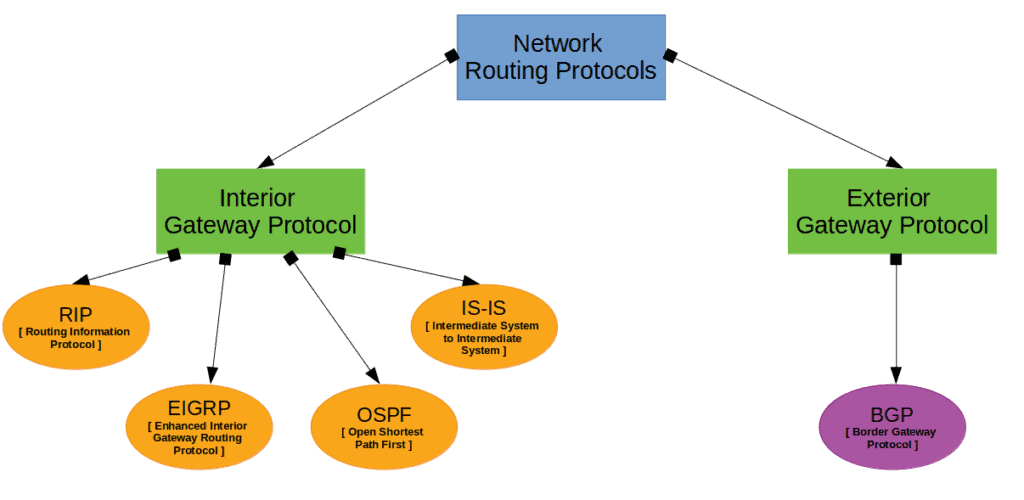1. 网络协议概述
作为网络管理员,在设计和排查网络问题时,经常会接触到 BGP、OSPF 等路由协议。这是因为这些协议是现代网络通信的基石。
本文将介绍常见的网络协议类型,并重点分析 EIGRP、OSPF 和 BGP 三者之间的主要区别。
2. 什么是网络协议?
网络协议是一组预先定义好的规则和标准,用于规范数据在设备之间的发送与接收方式。这些协议相当于计算机系统之间通信的“通用语言”。
OSI(开放系统互连)模型是实现系统间通信的标准框架。 在众多协议中,TCP/IP(传输控制协议/网际协议) 是应用最广泛的通信协议,它是一组用于网络通信的分层协议。
虽然大多数网络流量基于 TCP/IP,但还存在其他协议,例如:
- ICMP(互联网控制报文协议)
- IPSec(互联网协议安全)
- IGMP(互联网组管理协议)
这些协议通常由 IEEE、IETF、W3C、ISO 和 ITU 等组织制定和发布。
3. 路由协议简介
路由器是实现客户端与服务器之间通信的关键组件,它们通过路由协议选择最有效的路径来转发数据包。
为了找到最优路径,路由器依赖于路由协议,这些协议根据特定参数计算最佳路径并转发用户数据。
最常用的路由协议包括:
- BGP
- EIGRP
- RIP
- OSPF
- IS-IS

4. EIGRP vs OSPF vs BGP:核心区别
以下表格总结了 EIGRP、OSPF 和 BGP 的主要区别:
| 属性 | EIGRP | OSPF | BGP |
|---|---|---|---|
| 全称 | Enhanced Interior Gateway Routing Protocol | Open Shortest Path First | Border Gateway Protocol |
| 协议类型 | 距离矢量协议 | 链路状态协议 | 路径矢量协议 |
| 使用算法 | DUAL(扩散更新算法) | Dijkstra 算法 | 最佳路径算法 |
| 所属类别 | 内部网关协议(IGP) | 内部网关协议(IGP) | 外部网关协议(EGP) |
| 跳数限制 | 最大 224 跳(默认 100) | 无 | 无 |
| 是否支持无类路由 | ✅ | ✅ | ✅ |
| 是否支持 VLSM | ✅ | ✅ | ✅ |
| 收敛速度 | 非常快 | 快 | 慢 |
| 适用网络规模 | 大型 | 大型 | 极大型 |
| 使用的组播地址 | 224.0.0.10 | 224.0.0.5、224.0.0.6 | 无 |
| 使用端口号 | 88 | 89 | TCP 179 |
| 厂商兼容性 | 原为 Cisco 专有协议,2013 年开源 | ✅ | ✅ |
| 路由表标识 | 路由条目标记为 D | 路由条目标记为 O | 路由条目标记为 B |
| 路由计算机制 | 保存所有路由以实现快速收敛 | 基于 SPF 算法计算最短路径 | 依赖庞大的路由表进行路径选择 |
| 管理距离(AD值) | 内部 90,外部 170 | 110 | eBGP 20,iBGP 200 |
| 路径选择依据 | 带宽、可靠性、负载、延迟 | 带宽、开销 | BGP 属性 |
| 配置复杂度 | 基础配置简单 | 基础配置简单 | 基础配置易到中等难度 |
| 资源消耗 | CPU 和内存需求低 | CPU 和内存需求高 | 与路由表大小成正比 |
| 应用场景 | 适用于 Cisco 网络内部,不适合大规模跨厂商环境 | 局域网中首选动态路由协议 | 多 ISP 环境下的故障切换和路径选择 |
✅ 小贴士
- EIGRP 收敛快,但仅适用于 Cisco 网络内部,不适合跨厂商部署。
- OSPF 更适合中大型局域网,但对资源消耗较高。
- BGP 是 Internet 的“骨干协议”,适用于多 ISP 或跨自治系统的复杂网络环境。
⚠️ 踩坑提醒
- BGP 配置复杂,路径选择依赖大量策略和属性,容易出现路径选择错误。
- OSPF 在大规模网络中可能因链路状态数据库过大而导致性能问题。
- EIGRP 虽然收敛快,但跨厂商兼容性曾是个大问题(现在已改善)。
5. 总结
本文介绍了常见的网络路由协议及其基本原理。EIGRP、OSPF 和 BGP 各有优劣,适用于不同网络场景:
- EIGRP:收敛快、配置简单,适合 Cisco 网络内部使用。
- OSPF:支持大规模网络,适合局域网部署,但资源消耗较高。
- BGP:用于 Internet 和多 ISP 场景,支持复杂的路径控制,但配置和维护成本高。
在实际部署中,很多企业会同时使用多种协议,并通过路由重分发(Route Redistribution)实现互操作。合理选择路由协议,是构建高效、稳定网络的关键一步。